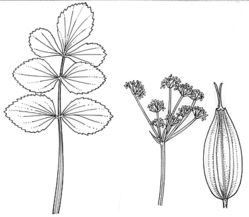Common name: mountain angelica
Gingidia rupicola I.Telford & J.J.Bruhl APNI* Synonyms: Gingidia sp. Point Lookout (E.F.Constable NSW41812) APNI*
Gingidia montana (J.R.Forst. & G.Forst.) Dawson APNI*

Description: Herbaceous perennial to 50 cm tall, with a thick fleshy rootstock and erect stems.
Leaves 6–10 per rosette up to 31.5 cm long, imparipinnate, leaflets 1–4 pairs, sometimes overlapping, the terminal pinnule sometimes 3-lobed, subcoriaceous, discolourous, upper surface grey-green, glaucous below, petiole 4.5–23.5 mm long, terete with a shallow channel on upper surface, sheathing at the base with marginal wings. Cauline leaves up to 9 cm long with 1–3 pairs of leaflets.
Inflorescence axillary, 1–6 per plant each with a terminal compound umbel and 1–3 lateral compound umbels, 6–11 cm long; involucral bracts 5; primary rays 6–11. Simple umbels 10–14-flowered.
Fruit a narrow-elliptic or narrow-ovate mericarp, 6.8–7.6mm long, 1.8–2.3mm wide, grey-brown, base rounded; dorsal surface convex with 5 ribs, 2 lateral ribs with wings 0.4–0.6mm wide; ventral surface flat; carpophore 4.5–6.8mm long
Flowering: Flowers summer.
Distribution and occurrence: The species grows in herb and shrub communities along cliff-lines, with aspects from east to south. In the vicinity of Point Lookout, New England National Park, at a 1400–1500-m altitude. Only known from 2 populations.
NSW subdivisions: NT
Threatened species: NSW BCA: Endangered; Commonwealth EPBC: Endangered
Text by Louisa Murray
Taxon concept: Heenan,P.B., Telford, I.R.H. and Bruhl, J.J. (2013) Three new species of Gingidia (Apiaceae: Apioideae) from Australia and New Zealand segregated from G. montana. Australian Systematic Botany, 2013, 26, 196–209.
APNI* Provides a link to the Australian Plant Name Index (hosted by the Australian National Botanic Gardens) for comprehensive bibliographic data
***The AVH map option provides a detailed interactive Australia wide distribution map drawn from collections held by all major Australian herbaria participating in the Australian Virtual Herbarium project.
|


